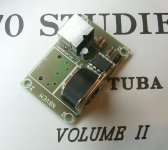Here's the first installment of the firmware, complete with LED control.
This uses a single PIC 16F629 8-pin microcontroller, one 47 uF decoupling capacitor, two 4.7K pullup resistors and one 1N4148 diode. If you install this inside of a keyboard, you could probably get rid of the decoupling capacitor--my installation is in the middle of a long cable, so better to be safe than sorry. I recommend socketing the PIC so it can be removed for reprogramming.
My own setup is a simple "enchanced" JDM parallel port programmer, although there are a lot of other possible ways to get the job done. (Just search for "PIC programmer" on eBay.)
I use
IC-Prog under Windows to do the deed; it's the only JDM programming software I've found that will reliably handle the configuration bits.
To compile, I use
GPASM, as it's small and straightforward, rather than the bloated
MPLAB PIC IDE, although this code also assembles just fine under MPASM.
That's about all I can think of at the moment.
Let me know what y'all think...

